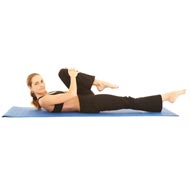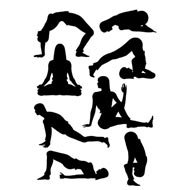- Raja yoga
- Yoga Stretches
- Jivamukti Yoga Poses
- Yoga Tree Pose
- Sun and Moon Yoga
- Hare Pose
- Accomplished Pose
- Urdhva Mukha Pinch Mayurasana
- Revolved Abdomen Pose
- Raised Foot Pose
- Scorpion Pose
- Butterfly Pose
- Half Tortoise Pose
- Revolved Twist
- Balancing Stick Pose
- Cat Pose
- Supported Shoulderstand
- Crane Pose
- Handstand
- Happy Baby Pose
- Firefly Pose
- Scale Pose
- Side Plank Pose
- Upward Facing Two-Foot Staff Pose
- Reclining Big Toe Pose
- Stick Pose
- Revolved Head-to-Knee Pose
- Full Boat Pose
- Upward Extended Feet Pose
- Yoga arm balance poses
- Core Yoga
- Inversion Yoga Poses
- Seated And Twist Yoga
- Horse Pose
- Cobbler Pose
- Seated Wide Angle Pose
- The Compass Pose
- Half Crow Pose
- Bound Half Moon Pose
- Lotus Pose
- Reverse Warrior Pose
- Fixed Firm Pose
- Back-bend Poses
- Forward bend Poses
- Sarvangasana
- Ashtanga Yoga Poses
- Warm up poses
- Seated Poses
- Seated Forward Bends
- Chair Poses
- Standing Poses
- Standing Balancing poses
- Yoga Asanas
- Hatha Yoga Asanas
- Yoga Postures Online
- Partner Yoga Poses
- Anusara Yoga Poses
- Advanced Yoga poses
- Restorative Yoga Poses
- Kids Yoga Poses
- Beginning Yoga Postures
Wind Removing Pose - Pavanamuktasana
The Wind Removing Pose or Pavanamuktasana is a yoga pose in which the body is positioned in a supine position. Everyone, regardless of whether he or she is a beginner or advanced practitioner, can practice this pose.
The Pavanamuktasana (Wind Removing Pose) massages the organs of the abdomen and also eases tension that occurs in the area of the belly and lower back.
The pose is also commonly called the Wind Relieving Pose. This pose gets its name from three major Sanskrit words namely; ‘pavana’ which means air, ‘mukta’ which means freedom as also release, and ‘asana’ which means pose. Another name for the Wind Removing Pose is the ‘One-Legged Knee-to-Chest Pose’.
Steps :
- Start off in the supine position with your back on the floor. Inhale deeply and bring one knee to your chest. Wrap your arms around your knee as your fold it in and clasp your fingers together. You can either interlock your fingers or hold the elbows of the opposite arm.
- Simultaneously, exhale, lift your head, and bring your chin toward your chest. Your tailbone and lower back should be pressed to the ground. Attempt to touch your forehead to your knee. You should feel the stretch along the length of your body from your legs to your back.
- Take a deep breath and hold this position for four to eight breaths. Your breathing should be deep from the belly, so that the belly presses against the thighs when you inhale.
- On an exhale, slowly return your head back on to the floor and straighten your legs.
Precautions :
- Avoid performing this pose just after you have had any surgery in the abdominal area or suffering from hernia.
- Do not attempt this pose if you have an injury in the spine or sciatica.
- You should also avoid this pose if you are pregnant.
- Do not perform this posture on a full stomach.
- Do ensure that you always practice all yoga poses within your abilities as also within limits.
Beginner’s Tip :
Make sure that you first begin the Pavanmuktasana with the right knee drawn in and your left leg extended. This will ensure that pressure is first applied to the mounting colon. When you change sides the pressure will be applied by the left leg on the sliding colon. This helps release any excess gas and stimulates digestion. In practicing this posture, there should be no pain and very little discomfort. The leg that is extended should also be kept straight as best as it can. Also ensure that your lower back is in contact with the floor or yoga mat at all times.
Benefit to Body Part :
- The wind removing pose provides a gentle massage to the organs of the digestive system. It helps improve the efficiency of the internal organs, stimulates the nerves, and increases the circulation of blood to the internal organs of the body.
- Practicing the wind removing pose also helps to get rid of any gases that are trapped in the large intestine.
- Performing this pose regularly helps improve the efficiency of the digestive system.
- The wind removing pose also loosens the spinal vertebrae and strengthens the muscles of the lower back.
- The Pavanamuktasana is also an excellent abdominal workout and helps tone and strengthen your core muscles.
- This pose also helps in getting rid of stubborn fat deposits from the buttocks, thighs, and abdomen.
- Another benefit of the Pavanamuktasana is that it helps massage the reproductive organs and pelvic muscles and is considered to be good for menstrual disorders.
Therapeutic Applications :
- Impotence and Sterility
- Menstrual Disorders
- Constipation
- Flatulence
- It alleviates mental sluggishness by enabling the release of toxins from the body
- It brings about mental clarity
- Activates the Apana Vaayu and Samaan Vaayu.
- Activates the prannic flow in the Manipur chakra and solar plexus.
Variations :
- In order to experience a deeper stretch, try touching your nose to your knee.
- Once you have mastered bringing a single knee to your chest, try to perform this posture by attempting to touch both knees simultaneously to your chest. This will increase the difficulty of the posture and provide you with a deeper stretch.
- If you have a protruding stomach or are new to the pose, you may experience some difficulty in getting your hands around your legs. In such a case, bring your knee to the side of the body instead of bringing it all the way up to your chest. If you are still not able to get your hands around your knees you could use a yoga strap. Wrap the strap around your knees and hold onto the strap with both hands.
- If you don’t want to bend your knees or hips too much you can hold the back of your knees or rest your feet on a wall.
- Other variations for the wind removing pose include the Standing Wind Removing Position and the Half Wind Removing Position. The Standing Wind Removing Position is performed while standing against a wall for support and balance. The steps are the same as for the regular Pavanamuktasana. In the Half Wind Removing Position, your shoulders, back, and head remain in contact with the floor at all times. You simply have to bring your knees to your stomach.
Although the Wind Removing Pose looks fairly simple, it can be challenging for some people. The Pavanamuktasana should ideally be performed on an empty stomach. Pay close attention to your breathing pattern when you are performing this asana and keep in mind that it is always best to perform all yoga poses under the guidance of an experienced instructor.



